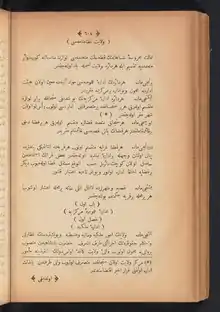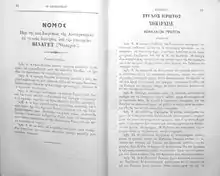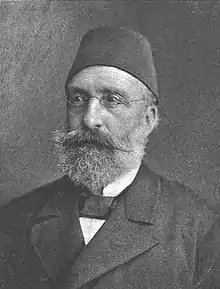Vilayet Law
The 1864 Vilayet Law (Ottoman Turkish: ولایت نظامنامهسی, Vilâyet Nizamnâmesi; French: Loi des vilayets[note 1], also known as the Provincial Reform Law, was introduced during the Tanzimat era of the late Ottoman Empire. This era of administration was marked by reform movements, with provincial movements led largely by Midhat Pasha, a key player in the Vilayet Law itself.[2] The Vilayet Law reorganized the provinces within the empire, replacing the medieval eyalet system.


Its date of initial publication in the Gregorian calendar was 8 November 1864, and the Turkish date was 7 Cümadelahir (Djem. II) or Jumaada al-Akhir (Jumada al-Thani) 1281. The law was modified in 1867. The Ottoman Turkish version was first published in Takvim-i Vekayi No. 773, and was published in Düstur Volume I, pages 517-538, and the 1867 version was printed in the Düstur Volume I, pages 608-624.[3] The Greek version was published in Оθωμανικοί Κώδηκες ("Othōmanikoi kōdēkes", meaning "Ottoman Codes", with Demotic Greek using "Οθωμανικοί κώδικες"), page 2911. The French version was published in Législation ottomane, published by Grégoire Aristarchi Bey, Volume II, page 273.[4]
Background
Vilayet
.png.webp)
Considered by some to model closely after the French Prefet system,[5][6] the new regulation subdivided the provinces of the empire into smaller subdivisions than the eyalet system had.[6] Where the eyalet system had only sanjaks as subdivisions, the vilayet system included kazas (smaller administrative units), towns (kasabat), villages (karye) or village clusters (nahiye).[6] Although the organizational titles were not created as a result of the Vilayet Law, the hierarchy in which they were set was.[7]
Sanjak
Each vilayet was divided into numerous integral units. Within each sanjak was a city center. Furthermore, each sanjak contained smaller administrative units, called kazas. Sanjaks, as administrative units, had existed within the empire for centuries.[7]
Kaza
The term kaza was originally used to designate areas of jurisdiction particular to each individual Islamic (Shari'a) court. The kaza, as an administrative unit, had existed within the empire since 1840. A particular and key feature of a kaza was that it was easy to reorganize at the discretion of the government: villages could be transferred between the existing kazas of a sanjak, while not necessarily eliminating a kaza in the process.[8]
Administrative Offices

The Vilayet Law created a bureaucratic hierarchy within each province, with many of the upper-level offices appointed directly from Constantinople (now Istanbul).[9] The list of upper-level, Ottoman government appointed officials is as follows:
- vali (translated to French as "gouvernor-général"[10])
- Overseer of the provincial justice system (müfettiş-i hukkâm/or mufettichi-hukkiami-cherie, French: Chef de la magistrature[11])
- Chief financial officer (muhasebeci, French: directeur des finances[11])
- Director of correspondence (mektubcu, French: directeur des correspondances[11])
- Director of real estate records (defter-i hakanî müdürü)
Lower-level officials appointed directly by the Ottoman government are as follows:
- Public works (nâfi’a)
- Agriculture (ziraat)
- Foreign affairs (umur-i ecnebiye, French: affaires étrangères[11])
- Census and cadastral surveys (tahrir-i emlâk)
Midhat Paşa, through his time as the vali of the Danube Vilayet came to institute other offices and institutions within the vilayet system.[12] The list is as follows:
- Superintendent of the vocational schools for orphans and homeless children (Islahhaneler naziri)
- Director of telegraph works and stations (telegraf müfettişi)
- Chair of the Danube river navigation board (Idare-i nehriye) (An office specific to the Danube province)
- Chair of the Immigration Commission (Muhacirîn komisyonu)
- Director of the agricultural credit cooperatives (Menafi-i umumiye sandiklari)
- Registrar of the Statistical Commission (Divan-i istatistik)
The office of the governor had been reorganized into departments of civil, financial, police, political, and legal affairs. Officially, the governor had authority over all officials within the province, having held the highest office. However, the governor did not appoint sanjak and kaza officials, appointed directly by the sultan. Furthermore, the governor’s authority is blurred when it comes to those officials who also reported to the respective ministries they served.[5]
Administrative and Judicial Councils (meclis)
In addition to reorganizing the provincial government, the Vilayet Law also included the institution of councils as advisory boards to government officials. These councils were made up of both elected and appointed officials, seeking a balance between the people and the Ottoman government. Each council had its own specific and fixed proportion of elected to appointed officials.[13]
The councils themselves were praised and mentioned by Ottoman statesmen as being the fulfillment of the promises made in the 1856 Hatt-i Hümayun for equal representation of both Muslim and non-Muslim members of the councils.[14]
However, there existed problems with this framework; the equality applied only to elected members (âza-yi müntahabe) of the councils, not the entire membership of the councils. This "promise", was not applied systematically throughout the vilayet system. The administrative councils of the kaza level were exempt, having only three elected members of unspecified faith. Furthermore, the Muslims wound up maintaining the majority in most provinces when the appointed positions came up, as most appointed officials wound up being Muslim.[15]
Administrative Councils (idare meclises)
The administrative councils served in an advisory capacity to the various provincial offices. Each provincial level (vilayet, sanjak, kaza, etc.) had its own advisory council. There were specific councils for the governor (vali), the kaymakams (sanjak governors), and the superintendents of the kazas. At the village level existed a Councils of Elders (Ihtiyar Meclisi) made up of entirely elected members with the purpose of advising the village headmen (muhtar).
The upper-level idare meclises acted as "control organs" for the decisions of the lower councils. For example, the Meclis-i Idare-i Vilayet routinely reviewed the decisions or resolutions passed by the sanjak and kaza level idare meclises.[16]
Council Election Process
The council election process was highly elaborate and involved. While being closest to democratic on a village level, the process became much more stringently controlled by the government as upper-level elections took place.
At the village level, the enfranchised were males with "ties" to the village who were over 18 years of age, paying 50-plus piastrtes in direct yearly taxes. These men were able to elect headmen and those sitting on the Council of Elders for their specified village. To stand for office, a male had to be thirty years of age or older with "ties" to the locality, paying a sum of 100 piastres in direct yearly taxes. These elections were held yearly and had to be verified by the superintendent of the kaza.[17]
At the kaza level, the elections were held every two years by an electoral commission. This commission was made up of the kaza müdürü, the kadi, the mufti, the imam, kaza scribes, and religious leaders of non-Muslim residents. The commission was charged with compiling a list of suitable candidates, 30 years of age or older who paid a sum of 150 piastres in direct yearly taxes and who were preferably literate. This list was then submitted to the Council of Elders, where about one-third of the candidates would be voted out. The list then passed for review to the kaymakam of the sanjak, where another third of the candidates would be eliminated. The remaining one-third of candidates made up the list of possible members.[18]
This same process was repeated for the sanjak- and vilayet-level councils. Higher property qualifications existed for each successive level of the hierarchy.[19]
This election process was to make the institutions "more amenable to state control under the guidance of appointed officials."[20] Wherein some semblance of participation was allowed. Another more likely reason for this election system exists as well: to "ensure that the meclises would no longer be hijacked by narrow local interests,"[20] thus allowing the meclises to serve the vilayet as they should.
Midhat Pasha
Midhat Pasha presided as vali over the most successful of the vilayets, initially the Danube province and then five years later over the Baghdad area.[21]
Midhat's successes have been attributed to his imaginativeness in governing and creating new offices and institutions, as well as his ability to heavily influence those directly appointed from Constantinople.[22]
Legacy
The Vilayet Law of 1864, although a strong reform movement in concept, has been seen as largely unsuccessful. That is not to say that there was failure in the division of offices and structure. It is to say that there was a failing in those appointed to the offices. Many officials were known to be incompetent, reluctant to leave Constantinople for a far-flung province, or susceptible to the existing political intrigue and struggle with the local notables (ayans) in the newly reorganized provinces.[21]
References
Sources
- http://www.britannica.com/EBchecked/topic/293631/Iraq/22899/The-governorship-of-Midhat-Pasa
- Young, George (1905). Corps de droit ottoman; recueil des codes, lois, règlements, ordonnances et actes les plus importants du droit intérieur, et d'études sur le droit coutumier de l'Empire ottoman (in French). 1. Clarendon Press.
- Naim Kapucu; Hamit Palabiyik (2008). Turkish Public Administration: From Tradition to the Modern Age
- Petrov, Milen V. 2006. "Tanzimat for the Countryside: Midhat Pasa and the Vilayet of Danube, 1864–1868." Order No. 3223822, Princeton University
- D. E. Pitcher (1972). An Historical Geography of the Ottoman Empire: From Earliest Times to the End of the Sixteenth Century. Brill Archive
- Walter F. Weiker. Administrative Science Quarterly, Vol. 13, No. 3, Special Issue on Organizations and Social Development (Dec., 1968), pp. 451–470
Reference notes
- Nicolaides, Demetrius. Оθωμανικοί Κώδηκες ("Othōmanikoi kōdēkes), Greek version of the Düstur. 1869. p. 72 (PDF p. 43). Available at Veria Digital Library.
- http://www.britannica.com/EBchecked/topic/293631/Iraq/22899/The-governorship-of-Midhat-Pasa
- Akiba, Jun. "From Kadı to Naib: Reorganization of the Ottoman Sharia Judiciary in the Tanzimat Period". In Imer, Colin; Keiko Kiyotaki (eds.). Frontiers of Ottoman Studies. 1. London/New York: I.B. Tauris. p. 43. ISBN 9781850436317. - CITED: p. 59 // Note "TV 773" means Takvim-i Vekayi No. 773.
- Young, Volume 1, p. 86.
- Weiker, 465
- Lapavitsas, Costas; Cakiroglu, Pinar (2019-08-08). Capitalism in the Ottoman Balkans: Industrialisation and Modernity in Macedonia. Bloomsbury Publishing. p. 48. ISBN 978-1-78831-659-0.
- Petrov, 82–83
- Petrov, 83–84
- Petrov, 87
- Young, Volume 1, p. 87.
- Young, Volume 1, p. 88.
- Petrov, 87–88
- Petrov, 89
- Petrov, 92
- Petrov, 92–93
- Petrov, 91
- Petrov, 95
- Petrov, 95–96
- Petrov, 96
- Petrov, 99
- Weiker, 466–467
- Weiker, 466
Other notes
Further reading
- Sublime Porte (1867). Sur la nouvelle division de l’Empire en gouvernements généraux formés sous le nom de Vilayets. Constantinople. - About the Law of the Vilayets
- Gençoğlu, Mustafa. "1864 ve 1871 Vilâyet Nizamnamelerine Göre Osmanlı Taşra İdaresinde Yeniden Yapılanma" (PDF). Çankırı Karatekin Üniversitesi Sosyal Bilimler Enstitüsü Dergisi. 2 (1): 29–50.
- Indzhov, Emil (2017). "THE BULGARIANS AND THE ADMINISTRATIVE REFORMS IN THE OTTOMAN EMPIRE IN 50-60 YEARS AT THE XIX CENTURY" (PDF). Proceedings of the University of Ruse (in Bulgarian). 56 (6.2).
External links
- Vilayet Law of 1864, official translation to French pp. 36–45, in Young, George, Corps de droit ottoman; recueil des codes, lois, règlements, ordonnances et actes les plus importants du droit intérieur, et d'études sur le droit coutumier de l'Empire ottoman, Volume 1, 1905.
- Vilayet Law of 1867, in French, in Législation ottomane, published by Gregory Aristarchis and edited by Demetrius Nicolaides, Volume 2
- 1864 Vilayet Nizamnamesi - TÜRK İDARİ ARAŞTIRMALAR VAKFI (TIAV) (in Turkish)
.png.webp)

